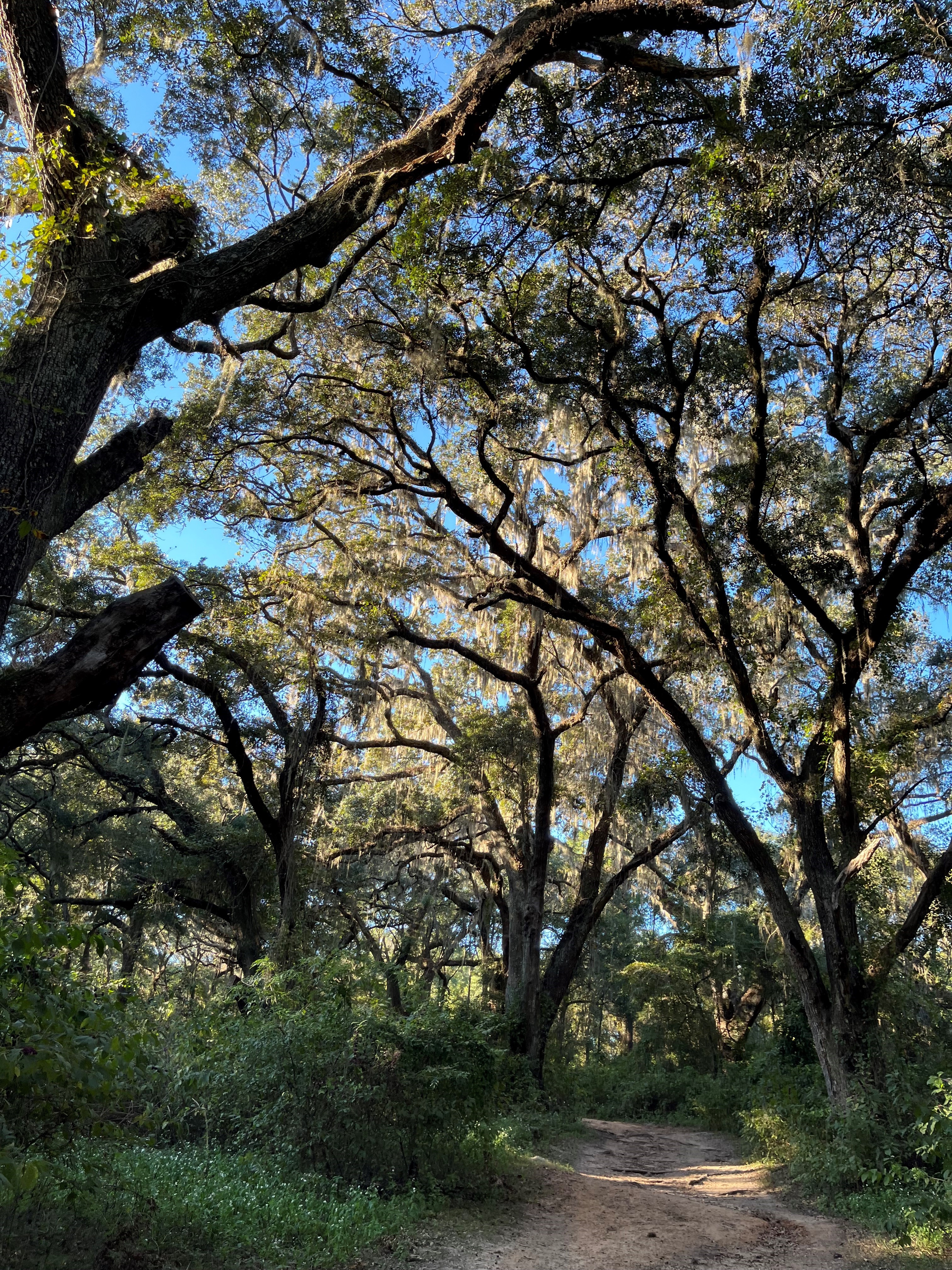
Trees provide shade, habitat, food, clean air, and beauty, but many also release windborne pollen that travels for miles, making spring challenging for allergy sufferers. Photo by Molly Jameson.
Spring in the Florida Panhandle brings blooming azaleas, singing birds, and a familiar yellow haze coating everything in sight. Yes, it’s tree pollen season, and if you’ve ever stepped outside only to feel your sinuses stage a full-scale rebellion, you have the trees to thank. Tree pollen is nature’s glitter – everywhere, impossible to escape, and surprisingly potent in small doses. While trees play a vital role in the environment, for allergy sufferers like me, their pollen can make spring feel like a months-long battle of sneezing, congestion, and itchy eyes.
Many people assume that showy, flowering trees are the biggest culprits, but this isn’t the case. Trees like magnolias and dogwoods rely on insect pollination, meaning their pollen is heavier and doesn’t travel far. The real troublemakers are wind-pollinated trees, which release huge volumes of lightweight pollen that can drift for miles and then straight into your sinuses.
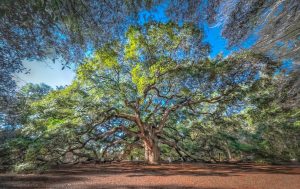
Oak trees are a staple of North Florida’s landscape, but their long pollen season makes them a top allergy culprit. Their lightweight pollen spreads easily, coating surfaces in yellow dust. Photo by Joseph Scopino, Bugwood.org.
Pollen production isn’t the same every year. Weather plays a big role – wind increases pollen spread, while rain helps suppress it. An unusually mild winter can start allergy season earlier and extend it longer, making some years worse than others.
To help you prepare, here are the top tree pollen offenders in our area, ranked using the Ogren Plant-Allergy Scale (OPALS), which rates allergenicity on a scale from 1 (least allergenic) to 10 (most allergenic).
Oak Trees (Quercus spp.)
OPALS Rating: 8
Pollen Season: February – May
Oaks are a staple of North Florida’s landscape, but they’re also one of the worst allergy offenders. Their pollen is light, easily airborne, and can travel miles on the wind. Even if you don’t have an oak in your yard, there’s a good chance one down the street is still making you sneeze.
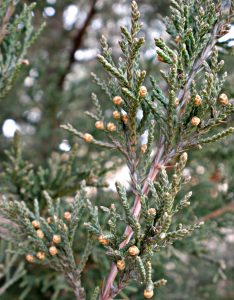
Male cones on Eastern Red Cedar release highly allergenic pollen in winter, often triggering “Cedar Fever.” Photo by Ansel Oommen, Bugwood.org.
Unlike other trees that release pollen in short bursts, oak trees drag out the misery from February through May, ensuring that allergy season lasts as long as possible. Because oaks are so widespread in urban and suburban areas, their moderate to high allergenicity makes them nearly impossible to avoid.
Eastern Red Cedar (Juniperus virginiana)
OPALS Rating: 10
Pollen Season: December – February
If you thought spring allergies were bad, Eastern Red Cedar makes sure some people suffer before spring even arrives. As one of the few trees to release pollen in winter, these evergreens begin shedding their highly allergenic pollen as early as December, peaking through February.
Cedar pollen is light, fine, and easily airborne, meaning it travels far and lingers in the air. The term “Cedar Fever” is well known in the Southeast for a reason – this tree’s severe allergenicity causes congestion, itchy eyes, and sneezing fits for many people, sometimes mistaken for winter colds. While red cedars provide valuable windbreaks and habitat for birds, their OPALS rating makes them one of the most problematic trees for allergy sufferers in North Florida.
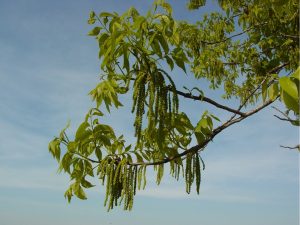
Pecan trees release long, dangling catkins in spring, shedding large amounts of wind-borne pollen. Photo by Charles T. Bryson, USDA Agricultural Research Service, Bugwood.org.
Hickory and Pecan (Carya spp.)
OPALS Rating: 8
Pollen Season: March – May
Closely related members of the walnut family, hickory and pecan trees may produce delicious nuts, but their wind-pollinated pollen is highly allergenic. Released in massive amounts from March through May, their pollen spreads far and often trigger strong allergic reactions.
Hickory pollen is especially potent, meaning even small amounts can cause sneezing, congestion, and itchy eyes. These trees are less common in urban settings compared to oaks, but in rural areas and agricultural landscapes, they can be a significant contributor to allergy misery.
American Sweetgum (Liquidambar styraciflua)
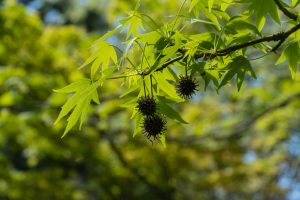
Sweetgum trees release allergenic pollen in spring, while their spiky seed pods linger long after. Photo by Alexander Denisenko, Adobe Stock.
OPALS Rating: 7
Pollen Season: March – May
While sweetgum trees are famous (or infamous) for their spiky seed pods, they’re also a problem during allergy season. Their wind-dispersed pollen, released from March through May, is known to trigger congestion and sneezing fits.
Although sweetgums have moderate to high allergenic potential, they do offer some benefits. They provide excellent fall color and support wildlife, so they’re not all bad – unless you’re allergic, in which case you might prefer to admire them from afar.
Pines (Pinus spp.), The Surprisingly Milder Offender
OPALS Rating: 4
Pollen Season: February – April
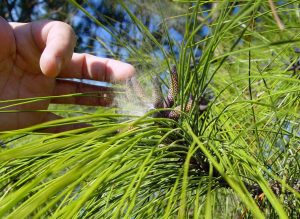
Each spring, pine pollen coats cars and sidewalks in a yellow-green haze. Though abundant, its heavier grains make it less allergenic than oak or cedar. Photo by Chris Evans, University of Illinois, Bugwood.org.
Wait, what about pine trees? If you’ve lived in North Florida for long, you’re probably familiar with the thick yellow-green coating of pollen that covers cars, sidewalks, and ponds every spring. It’s so visible that it seems like a top allergy culprit.
But here’s the twist: pine pollen is not as bad as you think. Despite its overwhelming presence, pine pollen is significantly less allergenic than oak, cedar, or pecan pollen. Its grains are larger and heavier, meaning they don’t stay airborne for long and are less likely to cause severe allergic reactions.
That said, sheer volume makes pine pollen hard to ignore. Pines are among the most common trees in Florida, and they release huge amounts of pollen from February through April. While their low to moderate allergy impact means they don’t cause major issues for most people, prolonged exposure can still be irritating – especially for those already dealing with other tree pollen allergies.
Other Notable Offenders

Red maple trees are among the first to release pollen in late winter, often kicking off allergy season. Their tiny, wind-dispersed pollen grains have a high allergenic impact. Photo by Gitta Hasing, UF/IFAS.
While the trees above may be the biggest allergy triggers, they aren’t the only ones sending pollen into the air. Red Maples (Acer rubrum) have an OPALS rating of 9, making them one of the most allergenic early bloomers. Their pollen often kicks off allergy season before winter fully ends, making them a significant irritant for those sensitive to tree pollen. American Elm (Ulmus americana), rated at 8, is another strong contributor, especially in urban areas where it has been widely planted.
Another surprising allergy trigger is Bald Cypress (Taxodium distichum), with an OPALS rating of 8. Though more commonly associated with wetlands and swamps, Bald Cypress releases significant amounts of pollen in the spring, making it an unexpected culprit. Sycamore (Platanus occidentalis), rated at 9, is a major pollen producer in North Florida, commonly found in parks and near waterways. Its fine, wind-dispersed pollen spreads easily, making it another frequent cause of allergy symptoms.
Managing Pollen Season
Tree pollen season in the Panhandle can be relentless, but a few simple precautions can help reduce exposure. Check pollen forecasts and limit outdoor activities on high-pollen days. Keep windows closed and use air filters indoors to minimize allergens. Since pollen clings to clothes, hair, and skin, showering and changing after being outside can prevent it from following you indoors. If you’re planning new landscaping, opt for low-pollen or female trees to reduce airborne allergens. With a little preparation, you can enjoy spring – without spending the whole season sneezing.
To learn more about trees that cause allergens and how they impact our region, check out the UF/IFAS Extension publication, Urban Trees and Allergies in North Florida.
- Cool Season Annual Herbs to Plant in December - December 11, 2025
- The Dirt on Compost: Hot and Worm Composting at Home - October 30, 2025
- Fall Gardening Spotlight: Collard Greens - October 3, 2025
